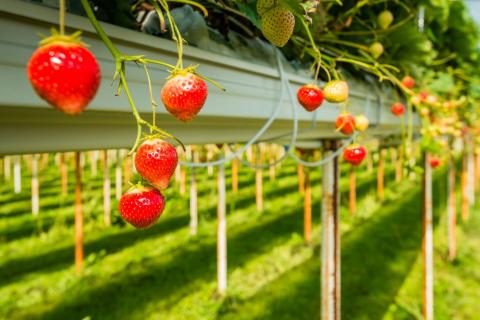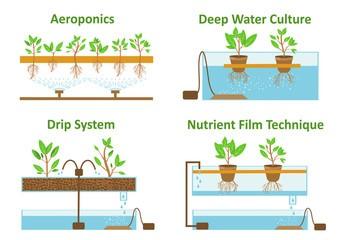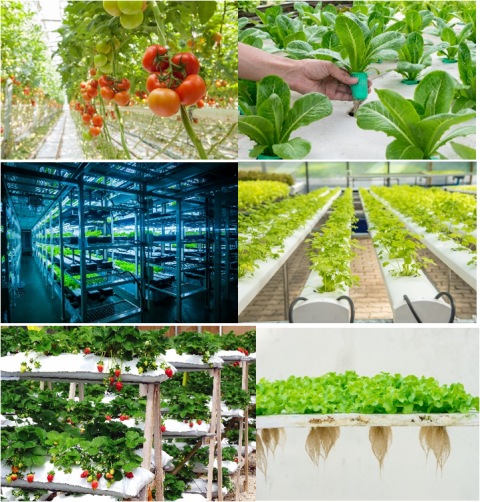2 September 2019
Dr Peter Wootton-Beard RNutr: IBERS, Aberystwyth University.
- Hydroponics offer an opportunity to diversify into horticultural production for businesses without suitable land resources.
- Hydroponic systems offer greater control and precision in the delivery of water, nutrients and crop management.
- As the technological complexity increases, the potential to design high precision, intensive production systems also increases.
Growing horticultural produce in soil has its challenges. In the case of (relatively) small-scale production – the focus of this technical article, many of these challenges are practical in nature. If plants are at ground level they are harder to harvest, an inconvenience for ‘pick your own’ customers, and they also require a large amount of space, require rotation to prevent disease build up, and high fertility. Numerous crops necessitate protection strategies to extend the season, which means moving physical structures, or increasing inputs. Uniformity of pollination and consistent quality (for fruiting crops) are also difficult to ensure.
Whilst hydroponic growing systems are not a ‘magic bullet’ of sustainable food production (as they are at times suggested to be) they offer practical advantages which can support a wider range of horticultural crops, or enable diversification into horticultural production. The article discusses the hydroponic techniques involved, the requirements for a grower, and the crops which are best suited to cultivation in these systems. Cautionary notes are provided on common challenges, and their limitations are discussed. Only 7% of Welsh land is classified in the top 3 grades for horticultural cultivation, therefore hydroponic systems offer a means to increase the amount of horticultural production to meet demand for fresh produce.
Hydroponic systems
The aim of all hydroponic systems is to enhance control and efficiency in crop production. In all cases, the environment in which plants are grown is the main limiting factor to their productivity. In a conventional outdoor production system, crops are at the mercy of the weather and soil conditions. Moving crop production from soil-based systems to hydroponic systems is the first step along a pathway of controlled environment production which culminates in fully indoor growing systems such as those seen in the vertical indoor farming movement. The ease of harvesting is also a key driver for a change away from soil-based growing, either as a result of a need to increase picker efficiency (due to increases in labour costs and a decrease in its availability) or to maximise opportunities for pick your own.
Table tops
The simplest and most common type of hydroponic systems are table tops. They have been embraced where soils have begun to offer diminishing returns (or require increased inputs), to improve the efficiency and comfort of harvesting, and where investments in crop protection are already necessary. They are commonly arranged as wire systems; a simple raised framework onto which bags of substrate are placed. These substrates are commonly either peat or coir based and arrive dried before being re-hydrated. Drip irrigation and fertigation apparatus are fed into each bag, allowing some control over nutrient and water use, but nutrient solution which is not used by the plant runs directly onto the floor beneath. Gutter systems can be open ended and contain substrate, or be adapted as (at least semi) re-circulating systems.
Recirculating/substrate-less systems
In these systems, roots are suspended directly into a nutrient solution and plants are held in place with inert substrates or plastic cups. Waste water and nutrient are recycled, increasing efficiency. There are several sub-types of these systems including ebb and flow, deep water culture, and nutrient film technique, the suitability of each is determined by crop type and physical infrastructure.
Ebb and flow (E&F) mimics a tidal pattern whereby the ‘flow’ phase corresponds with the level of water in the root zone rising, and the ‘ebb’ phase representing the period when it drains away. In this system the roots are periodically inundated with water from a supply tank for a short period of time, allowed to begin to dry out, before being inundated again in a cyclical fashion. Ebb and flow is commonly coupled with an inert medium into which plant roots are anchored (gravel, Rockwool, coir etc.). The periods of time when roots are not submerged removes the need for additional oxygenation.
Deep water culture (DWC) suspends the plant above a reservoir of nutrient solution in inert substrate blocks, whereby the roots grow down into the solution and remain submerged. The solution is oxygenated using an air stone/pump. The solution must be constantly adjusted, but can be tailored to different periods of a crop growth cycle. Variations on this technique include raft systems and aquaponic systems, the former uses a floating device to support crops, and the latter supplies nutrients in the form of waste produced by farming fish.
Nutrient film technique (NFT) suspends the plants above a thin layer of water (film) which flows constantly (and is recirculated) through a channel construction. Roots grow into the film of water, with the
top root layers remaining moist but exposed to the air, improving oxygenation. The system must be constructed with precise gradients, flow rates and channel lengths to achieve optimal supply of nutrient solution, whereby small inaccuracies can have considerable negative effects on crop growth.
Aeroponics is a recent advancement whereby plants are grown above a chamber into which the roots hang and within which a nutrient solution ‘mist’ is sprayed. This improves root zone oxygenation and may confer biological benefits such as reduced disease risk and the development of finer feeding roots. It is more complex than the hydroponics systems above, and presents challenges such as preventing obstructions in the spray nozzles. Recent advances include mists produced by vibration plates, and finer mists termed ‘fogponics’. The absence of water flows allow for more precise monitoring and adjustment, but these come at a financial cost.
Vertical systems have been designed using most, if not all, of the above technologies either by drip irrigating through multiple layers or through layers of stacked shelving where plants are provided with artificial light to compensate for the shading caused by the layer above. The most advanced of these are being adapted to form plant production systems which offer the potential for year round, indoor production of some crops in a factory-style operation. Vertical systems offer a more efficient use of space, and can be installed in less conventional locations, such as disused buildings.
Table 1
|
System |
Advantages |
Disadvantages |
Common crops
|
|
Table tops (wire or gutter) |
|
|
Strawberries Raspberries |
|
Ebb and flow |
|
|
Tomatoes, Cucumbers, Melons, Leafy greens. |
|
Deep water culture (Inc. aquaponics) |
|
|
Lettuce, salad greens, leafy vegetables. |
|
Nutrient film technique |
|
|
Watercress, leafy herbs, leafy salads. |
|
Aeroponics |
|
|
Potentially any, herbs and leafy salads, suitable for delicate crops. |
Growing Media
The aim of any hydroponic system is to deliver an optimised nutrient solution to plant roots. The method of delivery can often involve some form of growing medium used to anchor the plant, or to provide a matrix which supports nutrient and water accessibility. The interaction between the plant, growing medium and nutrient solution determines the efficacy of the growing environment. The most important factors governing the interaction between a substrate/growing medium and the nutrient solution are porosity, water holding capacity, water availability, buffering capacity and cation exchange capacity (CEC). These factors govern how quickly the nutrient solution passes through them, how often irrigation/fertigation is required, and how available nutrients are to the plants.
Pore space (porosity) determines how the roots grow through the material, but also how well oxygenated the root zone is. Water holding capacity determines whether water is held by the growing medium and water availability describes the ability of the growing media to assist plant roots to access water. Growing media with a low buffering capacity may have high water holding capacity and high water availability, but will need to be irrigated more frequently. Conversely, those with a lower water availability may hold onto some water for longer, offering a buffer against plants drying out. Cation exchange capacity is a measure of the same relationship, but between the media and nutrients. Those with a higher CEC will bind more of the nutrients, reducing their immediate availability to plants, but potentially lengthening the periods between fertigation episodes. A low CEC provides greater precision over nutrient delivery, but requires more frequent dosing.
Control of water and nutrients
Depending upon the degree of re-circulation, hydroponic systems offer varying levels of water conservation relative to soil based cultivation. Whilst this is a very worthy benefit in the context of climate change, the greater advantage is perhaps provided by the ability to deliver precision. The most advanced hydroponic and aeroponic techniques make it possible to deliver only the amount of water required by the plant for healthy growth, or indeed to withhold water for benefits which that may confer. The same principle is true for nutrients, which can be precisely mixed and delivered to plants and tailored to the species, growth stage and nutrient status of the plants. The amount and composition of the nutrient solution can be monitored in real time using sensor technologies, or in simpler systems, can be delivered according to a routine schedule which is matched to the general requirements of a specific crop (e.g. strawberries).
Crops
In principle, it is possible to grow any crop using hydroponics, provided the plant can access enough water and nutrients to support its growth. In reality, the case for hydroponic cultivation has to be made on an economic and/or environmental basis. In general these can be categorised into short duration and high input crops.
Short duration crops
Crops which reach maturity in a short period of time, but are sensitive to changes in environmental conditions are prime candidates. These include crops such as leafy greens, annual herbs and salad leaves. These crops often necessitate a degree of protection from pests and disease, as well as requiring careful control of irrigation to maintain leaf quality. In the case of leafy crops they can also be kept free from soil contaminants and harvested to order.
High input crops
Crops which require a high input of water/and or nutrients may be inefficiently produced in soil based systems, due to nutrient leaching and evaporation. These resources can be more precisely controlled in hydroponic cultivation leading to greater yields, reduced losses of water and nutrient to the wider environment, and greater uniformity of production. Example crops include ornamental flowers, tomatoes, strawberries, cucumbers and peppers.
Challenges
Pests and disease
Soil borne pests and disease are no longer a threat for hydroponically grown crops, but these systems do produce their own risks, such as water borne pathogens, particularly those which represent a biosecurity risk such as Phytophthora spp. or bacteria harmful to human health. These risks are greater in re-circulating systems where pathogens can build up over time and require that careful attention be paid to sanitation measures such as regular testing and treatment of irrigation water.
In covered crops, the risk of pest infestation can be increased due to more favourable conditions for plant growth also suiting insect reproduction. This can be dealt with through effective integrated pest management (IPM) strategies, but must be proactive. Some fungal disease are also encouraged by the warmer, humid conditions that are created in protected systems, and effective identification and treatment schedules are necessary.
Knowledge & cost
The main barriers to the use of hydroponics are the capital investment required, and knowledge of how to operate the control systems. In the case of soil-based production, the imprecision of the system allows for inaccuracy; it is relatively forgiving. In hydroponics, the precise nature of the growing method means that a small mistake can result in heavy losses. The cost of increased control and efficiency is (some) increased risk. Advice is available from a variety of organisations, and training is becoming more widespread and accessible. The costs associated with the various hydroponic techniques increase as the degree of precision improves. For each crop there will be a technique and scale which offers the best economic return. There is a vast array of equipment available, and the selection of a system will ultimately depend upon the individual choices of each grower.
Summary
Hydroponics represent a viable method for crop production, particularly where soil resources are diminished, or where land is not available. As the technological sophistication of the systems increase, they provide an opportunity to deliver efficient use of water and nutrients, and to sustainably intensify production. There is a cost to be borne both in terms of capital outlay and the acquisition of knowledge and technical skill, but with a good system design and operational protocol, hydroponics can deliver a more efficient production system for a range of valuable crops.



